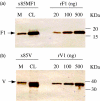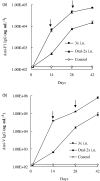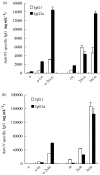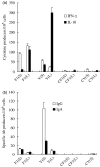A comparison of immunogenicity and protective immunity against experimental plague by intranasal and/or combined with oral immunization of mice with attenuated Salmonella serovar Typhimurium expressing secreted Yersinia pestis F1 and V antigen
- PMID: 17640293
- PMCID: PMC2121146
- DOI: 10.1111/j.1574-695X.2007.00280.x
A comparison of immunogenicity and protective immunity against experimental plague by intranasal and/or combined with oral immunization of mice with attenuated Salmonella serovar Typhimurium expressing secreted Yersinia pestis F1 and V antigen
Abstract
We investigated the relative immunogenicity and protective efficacy of recombinant X85MF1 and X85V strains of DeltacyaDeltacrpDeltaasd-attenuated Salmonella Typhimurium expressing, respectively, secreted Yersinia pestis F1 and V antigens, following intranasal (i.n.) or i.n. combined with oral immunization for a mouse model. A single i.n. dose of 10(8) CFU of X85MF1 or X85V induced appreciable serum F1- or V-specific IgG titres, although oral immunization did not. Mice i.n. immunized three times (i.n. x 3) with Salmonella achieved the most substantial F1/V-specific IgG titres, as compared with corresponding titres for an oral-primed, i.n.-boosted (twice; oral-i.n. x 2) immunization regimen. The level of V-specific IgG was significantly greater than that of F1-specific IgG (P<0.001). Analysis of the IgG antibodies subclasses revealed comparable levels of V-specific Th-2-type IgG1 and Th-1-type IgG2a, and a predominance of F1-specific Th-1-type IgG2a antibodies. In mice immunized intranasally, X85V stimulated a greater IL-10-secreting-cell response in the lungs than did X85MF1, but impaired the induction of gamma-interferon-secreting cells. A program of i.n. x 3 and/or oral-i.n. x 2 immunization with X85V provided levels of protection against a subsequent lethal challenge with Y. pestis, of, respectively, 60% and 20%, whereas 80% protection was provided following the same immunization but with X85MF1.
Figures







Similar articles
-
Expression of an F1/V fusion protein in attenuated Salmonella typhimurium and protection of mice against plague.Microb Pathog. 1997 Sep;23(3):167-79. doi: 10.1006/mpat.1997.0141. Microb Pathog. 1997. PMID: 9281474
-
Effective plague vaccination via oral delivery of plant cells expressing F1-V antigens in chloroplasts.Infect Immun. 2008 Aug;76(8):3640-50. doi: 10.1128/IAI.00050-08. Epub 2008 May 27. Infect Immun. 2008. PMID: 18505806 Free PMC article.
-
Comparison of mouse, guinea pig and rabbit models for evaluation of plague subunit vaccine F1+rV270.Vaccine. 2010 Feb 10;28(6):1655-60. doi: 10.1016/j.vaccine.2009.02.078. Epub 2009 Mar 9. Vaccine. 2010. PMID: 20079562
-
A nasal interleukin-12 DNA vaccine coexpressing Yersinia pestis F1-V fusion protein confers protection against pneumonic plague.Infect Immun. 2008 Oct;76(10):4564-73. doi: 10.1128/IAI.00581-08. Epub 2008 Aug 11. Infect Immun. 2008. PMID: 18694965 Free PMC article.
-
Protecting against plague: towards a next-generation vaccine.Clin Exp Immunol. 2013 Apr;172(1):1-8. doi: 10.1111/cei.12044. Clin Exp Immunol. 2013. PMID: 23480179 Free PMC article. Review.
Cited by
-
Developing live vaccines against plague.J Infect Dev Ctries. 2011 Sep 14;5(9):614-27. doi: 10.3855/jidc.2030. J Infect Dev Ctries. 2011. PMID: 21918302 Free PMC article. Review.
-
Principles of antidote pharmacology: an update on prophylaxis, post-exposure treatment recommendations and research initiatives for biological agents.Br J Pharmacol. 2010 Oct;161(4):721-48. doi: 10.1111/j.1476-5381.2010.00939.x. Br J Pharmacol. 2010. PMID: 20860656 Free PMC article. Review.
-
Mucosally delivered Salmonella typhi expressing the Yersinia pestis F1 antigen elicits mucosal and systemic immunity early in life and primes the neonatal immune system for a vigorous anamnestic response to parenteral F1 boost.J Immunol. 2009 Jan 15;182(2):1211-22. doi: 10.4049/jimmunol.182.2.1211. J Immunol. 2009. PMID: 19124765 Free PMC article.
-
Fine-tuning synthesis of Yersinia pestis LcrV from runaway-like replication balanced-lethal plasmid in a Salmonella enterica serovar typhimurium vaccine induces protection against a lethal Y. pestis challenge in mice.Infect Immun. 2010 Jun;78(6):2529-43. doi: 10.1128/IAI.00005-10. Epub 2010 Mar 22. Infect Immun. 2010. PMID: 20308296 Free PMC article.
-
A single immunization with a dry powder anthrax vaccine protects rabbits against lethal aerosol challenge.Vaccine. 2008 Oct 9;26(43):5494-502. doi: 10.1016/j.vaccine.2008.07.062. Epub 2008 Aug 12. Vaccine. 2008. PMID: 18703110 Free PMC article.
References
-
- Atkins HS, Morton M, Griffin KF, Stokes MGM, Nataro JP, Titball RW. Recombinant Salmonella vaccines for biodefense. Vaccine. 2006;24:2710–2717. - PubMed
-
- Bullifent HL, Griffin KF, Jones SM, Yates A, Harrington L, Titball RW. Antibody responses to Yersinia pestis F1-antigen expressed in Salmonella typhimurium aroA from in vivo-inducible promoters. Vaccine. 2000;18:2668–2676. - PubMed
Publication types
MeSH terms
Substances
LinkOut - more resources
Full Text Sources
Other Literature Sources
Medical
